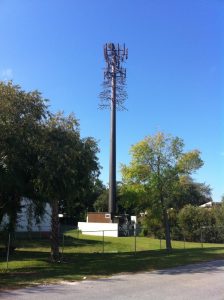When Stealthy Pine Trees Are Poorly Designed

9/23/15 Update: First of all, we’d like to mention that the term “Stealth” is a registered trademark of Stealth Towers. “Stealthy” can be used as an adjective to describe concealed towers, which is the non-trademarked way to refer to any towers that are designed to blend into the environment. Some concealed towers are designed to look like trees; others are meant to look like flagpoles or church steeples. As is typical for just about anything, some concealed towers are designed poorly while others are designed so well that it’s very difficult to spot them or notice that they are “fakes”.
For examples of poorly designed concealed towers, take a look at this link: https://www.pinterest.com/ken6148/fake-tree-cell-towers-bad/
For examples of well designed “stealthy” towers, see: https://www.pinterest.com/ken6148/fake-tree-cell-towers-good/
Many municipalities across the country (particularly in San Francisco) have added requirements into their municipal zoning codes that any new cell towers must be built as concealed towers. The reasons cited are 1. Concealed towers are less likely to result in community uproar regarding the safety of cell towers and any radiation emitted and 2. Concealed towers, especially when properly designed, are less likely to deter from the aesthetics of the community, which is of special importance when the town or city is known to be a tourist location.
Camouflaging cell towers, especially their antennas, has become more and more common for all wireless carriers, primarily the Big Four: AT&T, Verizon, Sprint and T-Mobile.
Scenic America, a nonprofit that works to preserve scenery along the nation’s roads, has generally opposed the building of more communication towers, but the group has been more amenable to disguised designs.
STEALTH Concealment Solutions Inc., a South Carolina-based company that offers hidden antennas and towers, has created dozens of multi-tasking steeples and crosses over the years, however other companies have recently come onto the scene who do it as well. At the end of 1997, the country had just over 50,000 cell towers. By the end of 2012, the most recent year for which information is available, that number had jumped to more than 300,000, and as that number continues to grow, the number of camouflaged towers will increase relative to the number of non-camouflaged towers.
10/11
This is a perfect example of what a poorly designed fake pine tree looks like with improper maintenance. The tower company recently painted it and it still looks like this. They weren’t willing to replace the needles even though they clearly need to be.











